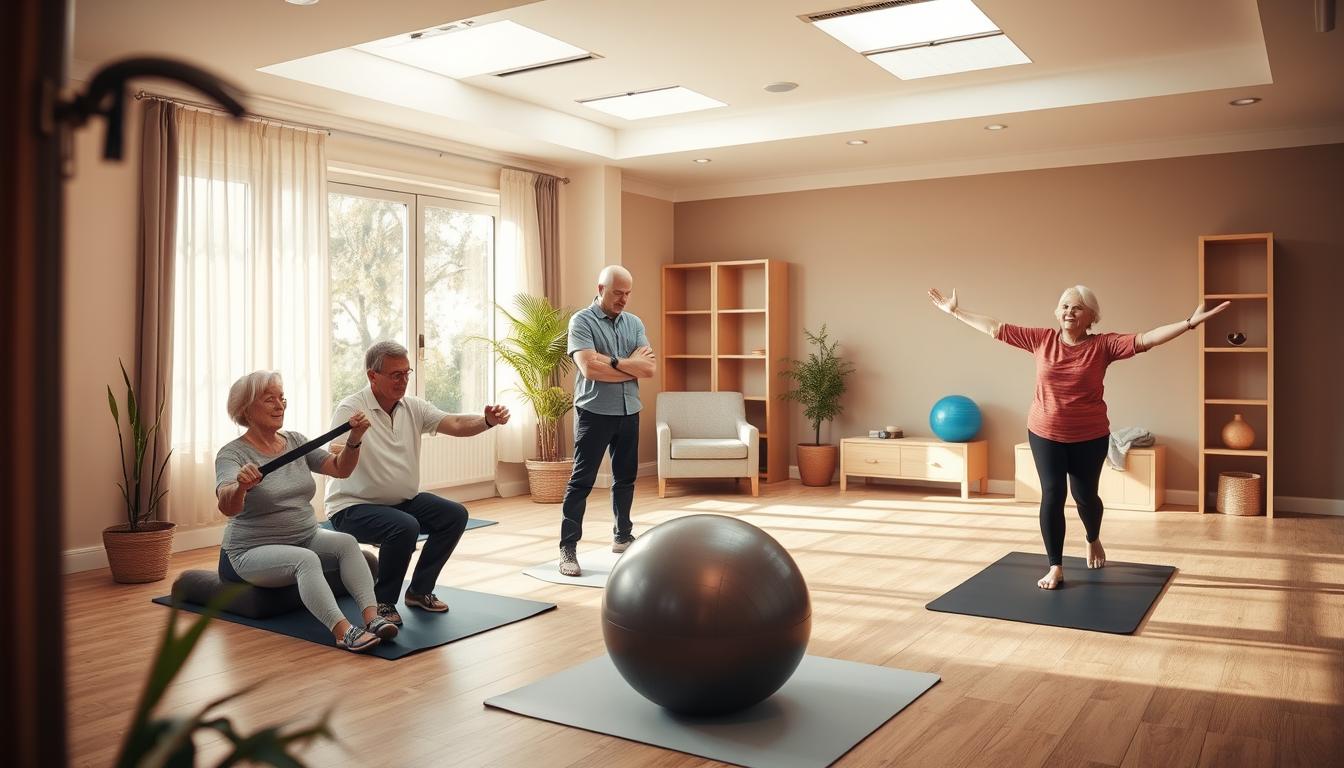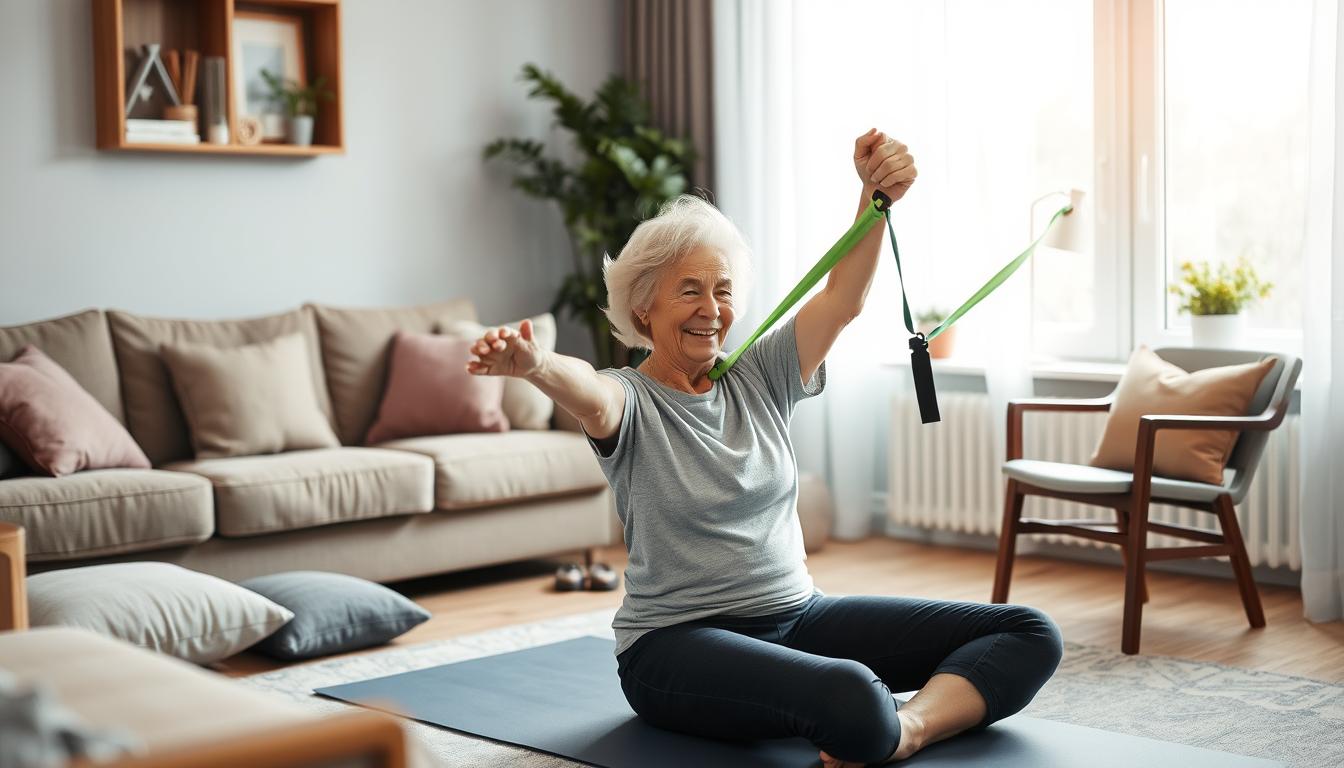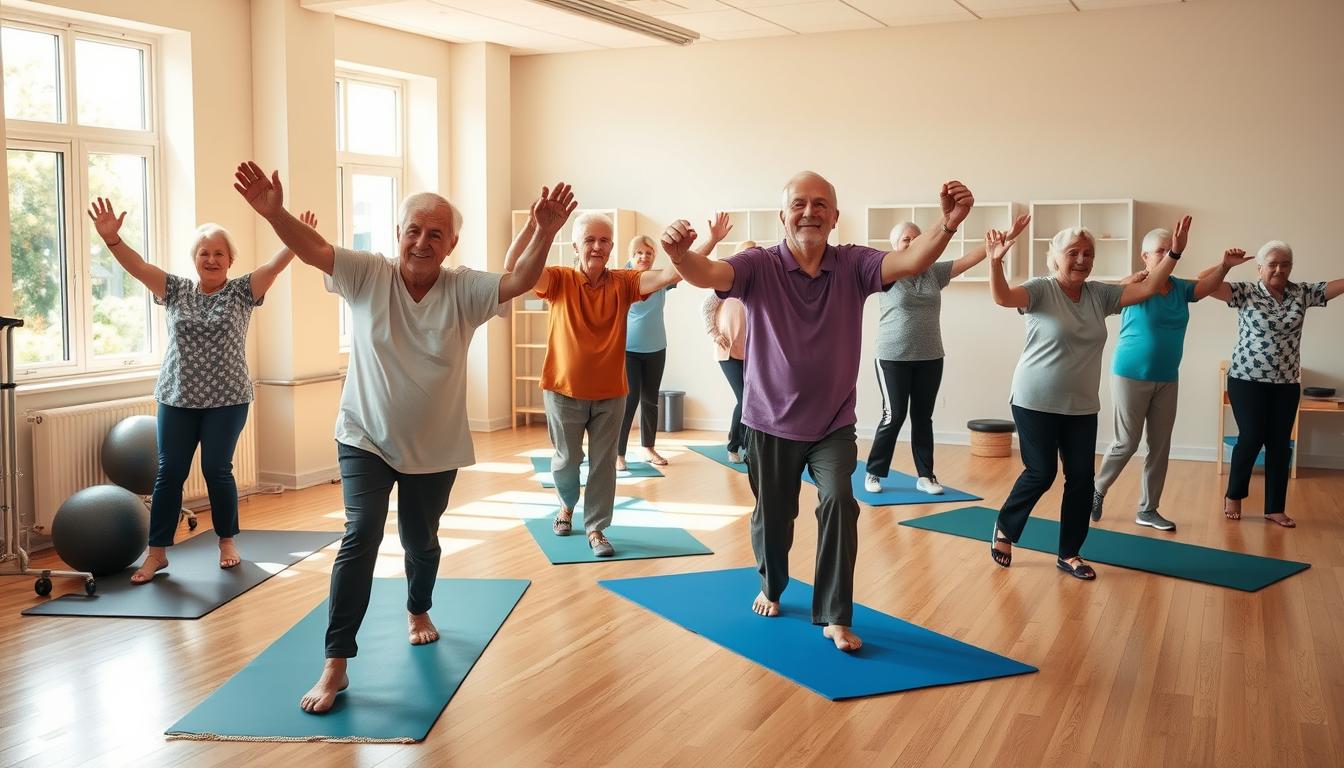Physical therapy is key for elderly patients to live better lives. Staying strong and moving well is essential for staying independent as we age. Geriatric rehabilitation helps build endurance and prevent falls in people 65 and older.
Did you know that one in four older adults falls each year? Physical therapy can significantly lower this risk. The Otago exercise program, backed by physical therapists, can reduce falls by up to 50% in older adults.
Senior fitness programs work to boost muscle strength, balance, coordination, and flexibility. These are vital for keeping independence and quick recovery from injuries or illnesses. Physical therapists create custom exercises to improve overall health and tackle specific health issues like arthritis and Parkinson’s disease.
Physical therapy for the elderly focuses on preventing injuries and slowing down functional decline. This approach helps seniors stay active, manage chronic conditions, and enjoy a better quality of life.
Understanding Physical Therapy for Elderly People
Physical therapy is key for older adults. It helps improve mobility, reduce pain, and enhance well-being. Let’s look at the main points of geriatric physical therapy and its benefits for seniors.
Definition and Importance of Geriatric Physical Therapy
Geriatric physical therapy is designed for older adults. It aims to boost strength, flexibility, and balance. Most of this therapy is done outside hospitals and is covered by Medicare Part B.
Key Benefits for Senior Health
Physical therapy offers many health benefits for seniors. It can help them recover faster from injuries or illnesses and manage symptoms of conditions like vertigo, Parkinson’s disease, and fibromyalgia.
Older adults should aim for 150 minutes of moderate activity weekly. This can include brisk walking, hiking, or dancing.
Role in Maintaining Independence
Physical therapy is essential for seniors to stay independent. It includes exercises to strengthen muscles, improve flexibility, and increase blood flow. In-home treatment is standard for those recovering from surgeries, strokes, or heart attacks.
Physical therapy helps seniors stay active and perform daily tasks independently by focusing on these areas.
Common Age-Related Mobility Challenges
Moving around becomes harder as one ages. Many seniors struggle with mobility issues that affect their daily lives. These problems can make walking, balancing, and coordinating movements challenging.
Falls are a big problem for older adults. They are a top reason for injuries and deaths in this age group. Fear of falling can make people less active, leading to more health issues.
About one-third of 70-year-olds and most 80-year-olds have trouble moving around their homes. Life-space mobility, or how far someone moves in a day, is linked to cognitive decline and other health issues.
Other common mobility challenges include:
- Difficulty with daily activities
- Less strength and flexibility
- Poor balance and coordination
- Chronic pain
- Gait problems
Two-thirds of older adults struggle with walking after leaving the hospital. Programs like CAPABLE help improve mobility and independence.
Addressing these mobility issues is essential to keeping seniors independent and happy. Regular exercise, using assistive devices, and making homes safer can help prevent falls and improve mobility.
Types of Geriatric Physical Therapy Programs
Geriatric physical therapy offers unique programs for older adults. These programs aim to boost mobility and fitness and reduce pain.
Orthopedic Physical Therapy
Orthopaedic physical therapy treats musculoskeletal injuries and helps after surgeries. It helps with arthritis, osteoporosis, and joint replacements. Exercises like leg presses and squats strengthen muscles.
Neurological Physical Therapy
Neurological physical therapy deals with brain issues like Alzheimer’s and Parkinson’s. It helps seniors with daily tasks, and exercises like standing on one leg improve balance.
Cardiopulmonary Physical Therapy
Cardiopulmonary physical therapy helps with heart or lung problems. It boosts endurance and independence. Walking and swimming improve heart health.
These programs are created by skilled geriatric physical therapists who work with a wide range of seniors. You can find a therapist through the American Physical Therapy Association’s “Find a PT” directory.
Essential Components of Senior Rehabilitation
Senior rehabilitation is key for tackling age-related problems and boosting well-being. It often focuses on conditions like arthritis, osteoporosis, and stroke recovery. Let’s look at the main parts of a good rehabilitation program for older adults.
Strength Training Exercises
Strength training is vital for seniors to keep muscle and bone strong. It targets big muscle groups, like the legs. Squats, leg presses, and resistance band exercises build strength and help with daily tasks.
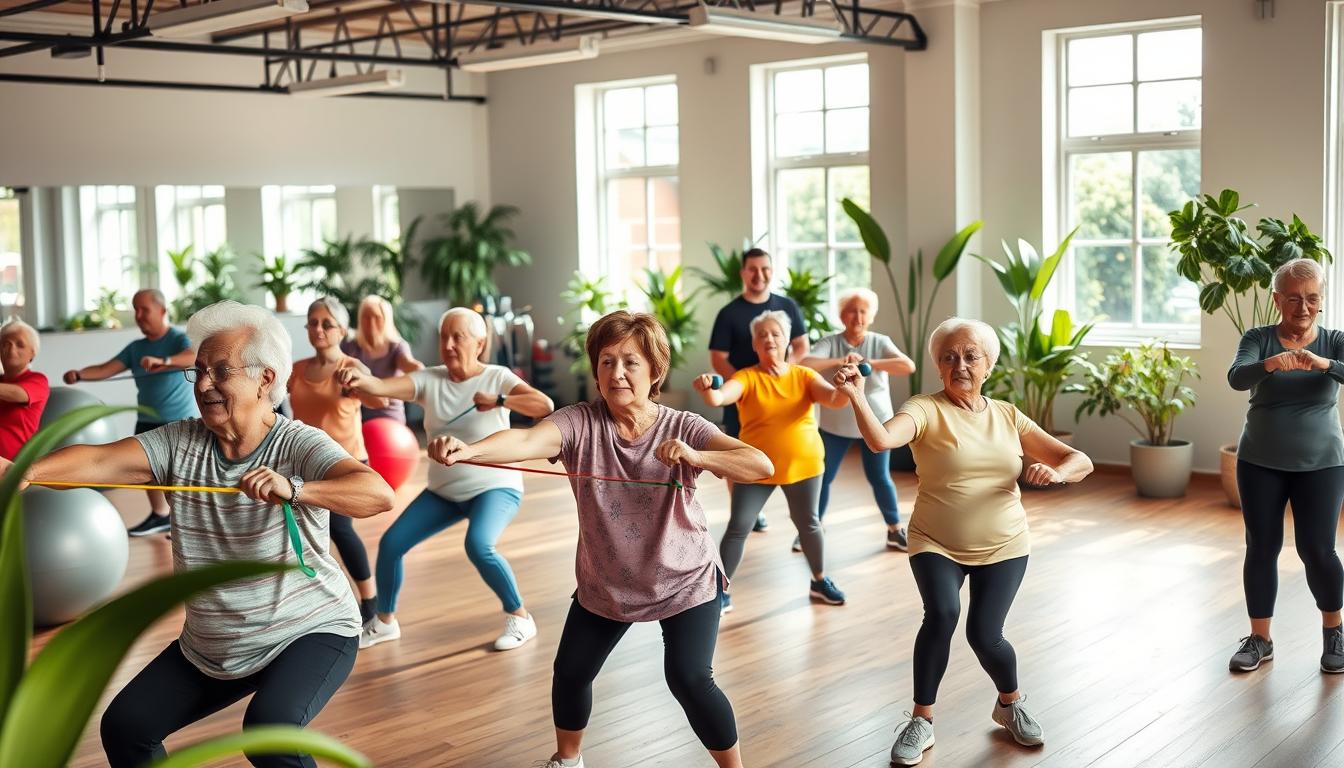
Balance and Coordination Activities
Balance exercises are key to preventing falls, which are a big concern for seniors. Activities like standing on one foot, walking heel-to-toe, or using balance boards are helpful. Regular practice boosts stability and confidence in movement.
Flexibility and Range of Motion Work
Flexibility exercises keep joints moving and reduce stiffness. Stretching routines for the lower back, hamstrings, and hip flexors improve posture and movement. Range of motion exercises are important for those recovering from surgeries like hip or knee replacements.
In-home rehabilitation services offer a personalized touch, making care plans fit each senior’s needs. This setting boosts motivation and active participation in therapy, with family support being invaluable. By combining these key elements, senior rehabilitation programs aim to improve independence, safety, and quality of life for older adults.
Fall Prevention Strategies and Techniques
Fall prevention is vital for seniors. Every year, over 25% of adults 65 or older fall, with 3 million treated in emergency rooms for fall injuries. Physical therapy helps lower fall risks for those 65 and older, saving money too.
Physical therapists do screenings and make plans to prevent falls. These plans might include:
- Balance training
- Walking and moving exercises
- Strength training
- Pain management
- Education on fall prevention
Programs like tai chi help older adults avoid falls. Regular exercise, with a doctor’s okay, can also help. It improves strength, balance, and flexibility.
It is also important to keep your home safe. Remove tripping hazards and make sure your home is well-lit. Doctors might suggest using canes, walkers, or grab bars to prevent falls. These strategies can help you lower your fall risk and stay independent.
Post-Operative Recovery Protocols for Seniors
Recovering after surgery is very important for seniors. As we get older, our bodies face special challenges. Up to 50% of elderly patients lose function before they even get to the hospital. And about 80% of them spend most of their time in bed, even when they don’t need to.
Joint Replacement Rehabilitation
Joint replacement rehab helps improve movement and strength. Patients work with therapists to do more activities. Therapists focus on exercises for the affected area, helping seniors perform daily tasks independently.
Getting up and moving early is very important. It helps prevent problems and speeds up recovery.
Cardiac Surgery Recovery
A careful plan is needed to recover from cardiac surgery. Pre-surgery physical therapy can help reduce complications and shorten hospital stays.
A structured program helps improve heart health. Patients learn breathing and movement techniques. These help them heal safely.
General Surgery Recovery Guidelines
General surgery recovery focuses on moving early and managing pain. Surgery can quickly weaken muscles and heart health. A study showed that seniors who did physical training after surgery improved greatly. They improved their ability to move, think, and feel good about life.
Good post-operative care for seniors means tailoring plans to their needs. Starting rehab early is key. With the right care, seniors can become strong and independent after surgery.
Managing Chronic Conditions Through Physical Therapy
Physical therapy is key in caring for the elderly. Many seniors face health issues, often with two or more chronic conditions lasting over three months. Physical therapists assess mobility, such as strength, balance, and flexibility, to design specific treatment plans.
Managing arthritis is a big part of geriatric physical therapy. Activities like Tai chi, yoga, and a healthy weight can ease pain and improve joint health. Physical therapists also work on balance, addressing muscle weakness or ear issues.
Physical therapy helps manage symptoms and improve quality of life for diseases like Parkinson’s or multiple sclerosis. Almost 80% of physical therapists work with older adults, strongly focusing on this group. This ensures seniors get care that meets their specific needs.
- Regular physical therapy sessions
- Customized exercise programs
- Pain management strategies
- Fall prevention techniques
To find a good physical therapist, use the American Physical Therapy Association’s “Find a PT” tool. This tool lets you search by location, focus, and specializations, such as geriatrics or fall prevention. For the best treatment plan, always tell your physical therapist about your symptoms, medical history, and goals.
Exercise Equipment and Assistive Devices
Staying active is key for seniors’ health and freedom. The right gear and tools can help keep them fit and safe at home.
Recommended Tools for Home Exercise
Elliptical machines are perfect for older adults. They offer low-impact workouts that are gentle on the joints. The SOLE E25 Elliptical has 20 incline levels and Bluetooth for music streaming.
Treadmills like the LifeSpan TR2000i support heart health and help burn calories. Resistance bands are great for strength training. They are lightweight and adjustable. The Healthy Seniors Chair Exercise Program with resistance bands costs $25.99 on Amazon.
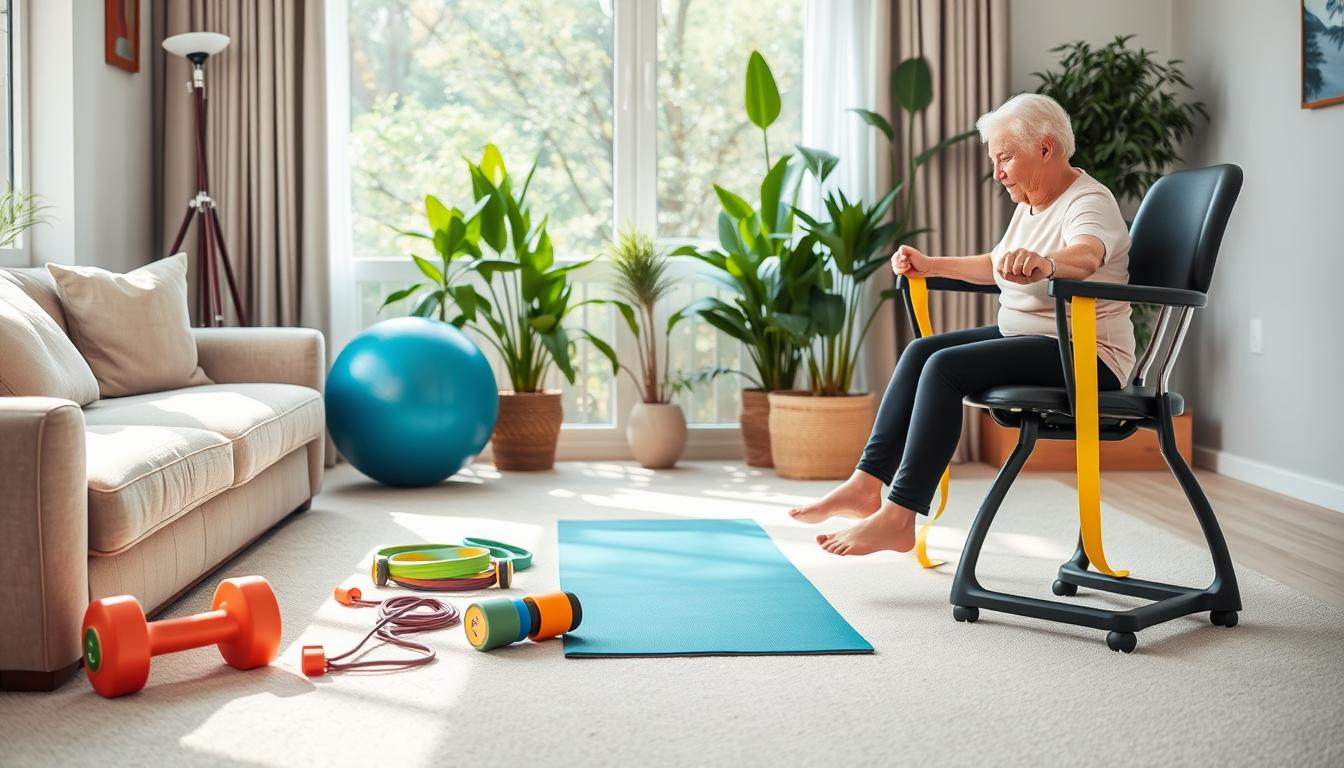
Safety Equipment Selection
Safety is vital when choosing gear for seniors. Stability balls improve balance and posture. The DYNAPRO Exercise Ball, made of eco-friendly PVC, comes in various sizes and costs between $17.99 and $27.99.
The Apple Watch is a top pick for tech-savvy seniors. It tracks fitness and is easy to use.
Proper Usage Guidelines
It is important to use exercise equipment correctly. Aim for at least 30 minutes of daily exercise to lower the risk of chronic diseases. Regular physical activity can improve sleep quality, reduce fall risks, and help manage arthritis and diabetes.
Remember, exercise isn’t just good for your body. It can boost your social life and help you live longer, too.
Pain Management and Treatment Approaches
Pain management is key for seniors. Over 50% of older adults deal with chronic pain, with 70% feeling pain in more than one area. This shows the need for effective pain relief for the elderly.
Physical therapy is a non-drug way to help seniors with pain. It uses exercises, manual therapy, and treatments like heat or cold. This method helps reduce the need for pain meds, which can harm older adults.
Seniors face special challenges in managing pain. Like younger people, 24-50% of older adults have persistent pain. Physical therapists create plans that take into account these challenges.
Exercise and physical therapy can make seniors feel more comfortable and less in pain than meds alone. This shows how important it is for seniors to manage their pain actively.
To manage pain in seniors, physical therapists, doctors, and other healthcare workers must collaborate. Regular check-ups with pain specialists help track progress and make needed changes.
By using physical therapy along with other pain management methods, seniors can live better lives. They can function better and avoid the dangers of long-term medication use.
Role of Physical Therapy in Daily Living Activities
Physical therapy is key for seniors to stay independent and enjoy life. It helps them do daily tasks at home and with friends. This makes a big difference in their lives.
Improving Mobility at Home
Getting around safely is a big goal of physical therapy for seniors. Therapists help them move better in their homes. They practice getting out of bed, using the bathroom, and going up stairs.
These exercises are made just for each person. They help lower the chance of falls.
Enhancing Personal Care Independence
Physical therapy also helps with personal care tasks. Therapists teach exercises to boost strength and flexibility. This makes dressing, bathing, and grooming easier.
These efforts help seniors keep their dignity. They also need less help from others.
Social Activity Participation
Being social is important for seniors’ minds and hearts. Physical therapists help by making it easier to move and feel confident. They suggest exercises to improve heart health.
This lets seniors walk or swim with friends. It’s a great way to stay active and happy.
Physical therapy focuses on key areas to improve seniors’ lives. A study found it made a big difference in their abilities. It shows how important it is for staying independent and happy in old age.
Caregiver Education and Support Systems
Caring for elderly loved ones can be challenging. As the U.S. population ages, more people will find themselves caring for others. By 2060, one in four Americans will be 65 or older, demonstrating the need for caregiver education.
Learning to care for seniors is key. It helps family members support their loved ones well. Physical therapists are important in this learning. They teach safe ways to move seniors, how to use assistive devices, and support exercise at home.
However, about 60% of caregivers don’t receive formal training. This shows that we need strong support systems for senior care. Luckily, there are resources to help caregivers learn and perform their duties.
Government sites, private groups, and online platforms offer great help. They cover important topics like:
- Safety measures for seniors
- Mobility assistance techniques
- Managing challenging behaviors
- Stress management for caregivers
- Communication with healthcare professionals
Caregivers often spend 20 hours a week caring, with some doing 40 or more. This can harm their health. Support systems like adult day care and home care help caregivers.
Families can provide better care by investing in caregiver education and using support systems. They can also maintain their own health and happiness.
Conclusion
Physical therapy is very helpful for older adults. It helps them move better and feel better. With more seniors in the U.S., this care is even more important.
It helps them stay independent and live better lives. But, many seniors don’t use physical therapy as much as they could. Only 13% of those at risk for falls get the help they need.
This is a big problem. Exercise can really help, cutting falls by 15% and the number of falls by 23%.
We need to tell more seniors about physical therapy’s benefits. Physical therapists can help with strength, balance, and pain, helping seniors stay active and independent.
It’s important to stay active. Aim for 150 minutes of moderate exercise and muscle-strengthening twice a week. With the right help, physical therapy can make your later years great.

